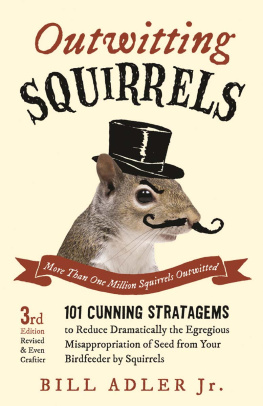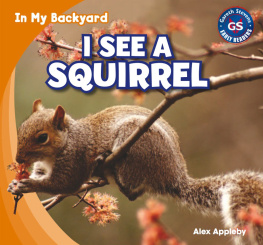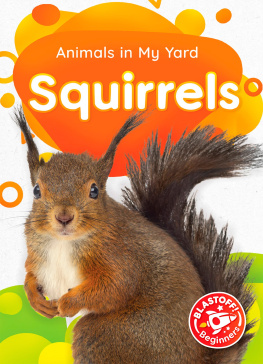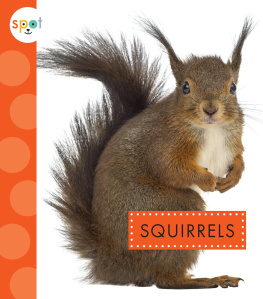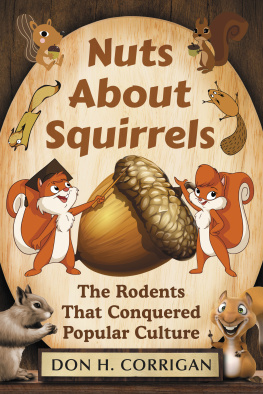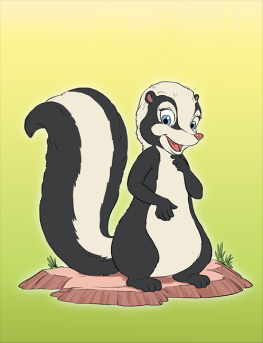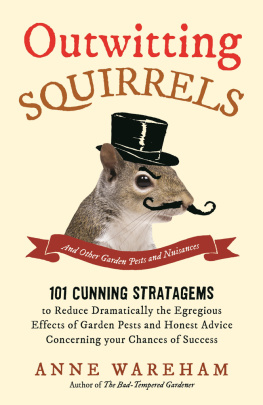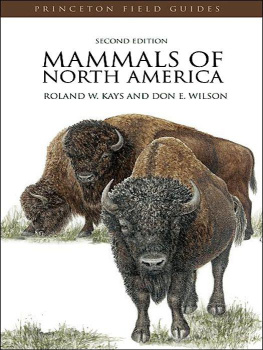Squirrels
The Animal Answer Guide
Richard W. Thorington Jr. and Katie Ferrell

Squirrels: The Animal Answer Guide
Squirrels: The Animal Answer Guide
2006 The Johns Hopkins University Press
All rights reserved. Published 2006
Printed in the United States of America on acid-free paper
9 8 7 6 5 4 3 2 1
The Johns Hopkins University Press
2715 North Charles Street
Baltimore, Maryland 21218-4363
www.press.jhu.edu
Library of Congress Cataloging-in-Publication Data
Thorington, Richard W.
Squirrels : the animal answer guide / Richard W. Thorington, Jr., and Katie E. Ferrell.
p. cm
Includes bibliographical references and index.
ISBN 0-8018-8402-0 (hardcover : alk. paper) ISBN 0-8018-8403-9 (pbk. : alk. paper)
1. Squirrels. I. Ferrell, Katherine E., 1974 II. Title.
QL737.R68T48 2006
599.36dc22 2005032061
A squirrel leaping from bough to bough, and making the wood but one wide tree for his pleasure, fills the eye not less than a lion, is beautiful, self-sufficing, and stands then and there for nature.
RALPH WALDO EMERSON
Introduction
In the late afternoon, Thorington and his host drove to a shrine on the outskirts of Tokyo. They walked up a broad, well-maintained path from the parking lot into the shrine. Above them were magnificent old Japanese cedars, the famed cryptomeria trees; the understory consisted of maples and a variety of other trees that Thorington did not recognize. His host, Dr. Imaizumi, pointed to a tree hole, and Thorington trained his binoculars on it. Soon, a squirrels head appeared, giving him his first glimpse of a wild Japanese giant flying squirrel. He watched impatiently as the squirrel withdrew its head, then reappeared, and again withdrew its head. Suddenly, it emerged and seemed instantly to dash to the backside of the tree and out of sight. He vividly remembers his sinking feeling: he had seen a giant flying squirrel but just barely. Then, from higher in the tree, the same squirrel appeared and launched out into a gliding flight to the base of another tree. Soon the darkening shrine seemed full of squirrels, calling excitedly and gliding back and forth overhead. They had been confined to their nests for several days by a typhoon, and this was their first dry, windless night. Too soon, it was dark and Thorington followed Dr. Imaizumi as they retraced their steps to the car, but the thrill of that evening, 30 years ago, is still with him.
Thoringtons interest in squirrels started long before then, probably with his unsuccessful attempts as a boy to keep them from raiding his bird feeder. When he came to the Smithsonian 36 years ago, his enthusiasm increased when he began to examine the worldwide diversity in the museum collection, from giant flying squirrels to pygmy tree squirrels, from large Asian marmots to least chipmunks, from common eastern gray squirrels to rare Borneo sculptor squirrels. It always helps to have someone to share your enthusiasm with, and he was fortunate to find an extremely enthusiastic high school student, Larry Heaney, already at work helping to cu-rate the squirrel collection. Larrys cry, Sciuridae Forever! still seems to resonate through the hallways of the Smithsonian, although now he is the much more sedate, silver-haired Curator of Mammals at the Field Museum in Chicago. Throughout their careers Thorington and Heaney have continued to collaborate on squirrels.
As a curator of one of the largest squirrel collections in the world, Thor-ington answers many questions about squirrels, asked by a wide variety of people. This book is designed to provide answers, both to these questions and to questions that we think should be asked. As we have reviewed the literature on squirrel biology, we have looked for facts and interrelationships of general interest, and these we have arranged as answers to relevant questions.
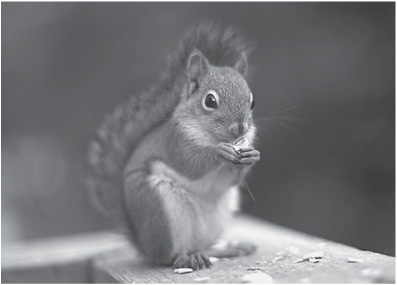
Inquisitive, industrious, talkative, and energetic are terms commonly used to describe the squirrel. Photo Plaistow John, www.scarysquirrel.org
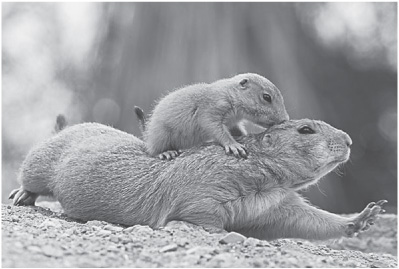
Many people may not realize that prairie dogs, like this black-tailed prairie dog (Cynomys ludovicianus) mother and pup, are also squirrels. In all, there are 278 species of squirrels around the world. Photo Shirley Curtis, www.scarysquirrel.org
One of the exciting things about focusing on a group of animals is that when you look closely, fascinating connections appear. For example, there are interrelationships between the fossil history of the squirrels and their current distribution around the world; their anatomy and their ecology; and their ecology and their behavior.
The worldwide diversity of squirrels is astounding. There are 278 species, which occur on five continents. We like to say, The sun never sets on the Sciuridae! This diversity encourages informative comparisons. The ground squirrels and tree squirrels of Africa exhibit differences from those of North America and northern Eurasia, which are different again from those of Southeast Asia.
These differences raise tantalizing questions about their behavior, ecology, morphology, and evolutionary history. Some of these questions we can answer, and some of them we cannot. Therefore, an animal answer guide, like this one, is inevitably a work in progress. We hope our readers will view it as such, and that our answers will provoke more questions and stimulate more inquiries into the biology of squirrels.
Acknowledgments
Many persons have shared and encouraged our enthusiasm for the study of squirrels. We would like to thank them all, but we must restrict our acknowledgments to those who have played special roles. These include Thoringtons mentors in graduate school, Charles Lyman and Ernst Mayr, who directed him into the field of mammalogy, and Ferrells mentor, Gerald Svendsen, who gave her an appreciation for mammalian biology. Over the years, Thorington has collaborated with and learned from a number of colleagues and assistants, including C. Gregory Anderson, Amy Betts, Andrea Cardini, Jeff Chu, Rich Cifelli, Lindsay Pappas Davis, Karrie Darrow, John Eisenberg, Robert Emry, William Glanz, Lawrence Heaney, Robert Hoffmann, Sharon Jansa, Jennifer Leonard, Jesus Maldonado, Amy Musante, Diane Pitassy, Louise Roth, Chad Schennum, Brian Stafford, and Robert Voss, to all of whom he is grateful.
At the Smithsonian, we have been privileged to work with a large museum collection of squirrels, perhaps the largest in the world, and a superlative library. In addition, we have had financial support from the Smithsonian, not just with the preparation of the book but also for fieldwork, visits to other museums, and research on the collections. The Environmental Science Program and Scholarly Studies Program have supported much of Thoringtons work. Thorington is especially thankful for the institutional support that he has received, enabling him to continue working although quadriplegic.
The Division of Mammals has been Thoringtons intellectual home for 36 years, and he wishes to express his appreciation to past and present colleagues there for many informative discussions and debates about mammalian biology, especially taxonomy and systematics. Don Wilson suggested this book and encouraged us to write it, and Bob Hoffmann has been a wonderful source of information and enthusiasm. In the writing of this book, we have been guided and encouraged by Vincent J. Burke, Senior Editor, of the Johns Hopkins University Press, who responded quickly to all our questions and concerns. We would also like to thank Michael Steele for his thoughtful comments and suggestions during the review process. We are grateful for poetry and literature quotes on squirrels from Phil Clapham and the members of QDJ, especially Julie Warfield, Sharon Young, and Yulia Alper.


